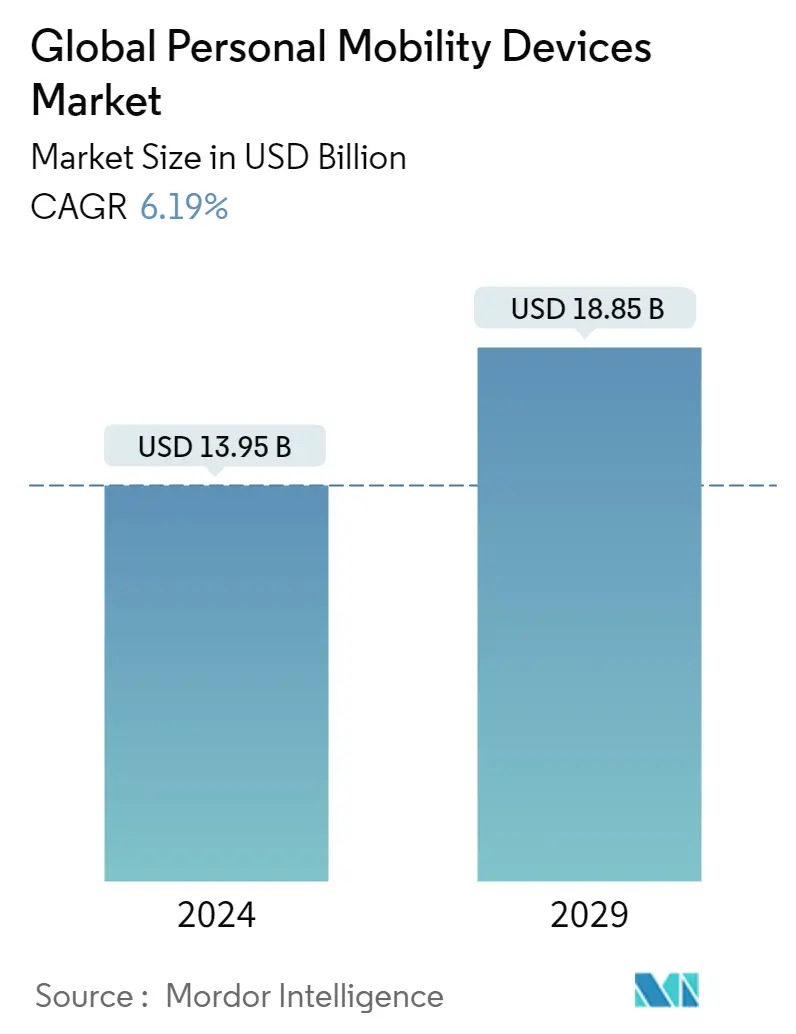Market Size of Global Personal Mobility Devices Industry

| Study Period | 2019 - 2029 |
| Market Size (2024) | USD 13.95 Billion |
| Market Size (2029) | USD 18.85 Billion |
| CAGR (2024 - 2029) | 6.19 % |
| Fastest Growing Market | Asia Pacific |
| Largest Market | North America |
Major Players
*Disclaimer: Major Players sorted in no particular order |
Personal Mobility Devices Market Analysis
The Global Personal Mobility Devices Market size is estimated at USD 13.95 billion in 2024, and is expected to reach USD 18.85 billion by 2029, growing at a CAGR of 6.19% during the forecast period (2024-2029).
Many people with chronic conditions or people with physical disabilities are not able to follow the guidelines and procedures to reduce the spread of COVID-19. For example, complete isolation may not be possible for a person with a disability because you need help from home helpers or caregivers. If the outbreak becomes more severe in the area, those services may be disrupted as the attendants become ill themselves. Some may not have access to affordable travel and may have to rely on mobility devices to continue receiving medications or making purchases.
The pandemic has a significant effect on the market as the epidemic has disrupted and can continue to disrupt the performance of the major manufacturers and can have a significant effect on the business and financials of the market, including the ability of end-users to gain access to products.
The major factors contributing to the growth of the market are the increasing number of disability cases due to the growing elderly population, an increasing number of road accidents, spinal cord injuries, and meningitis.
According to the revised World Population Prospects by the United Nations 2020, the number of people aged 60 years or above is expected to grow more than double by 2050, from 962 million in 2015 to 2.1 billion by 2050 worldwide. This age group is at high risk for various age-related illnesses, which require the help of personal mobility. According to Disabled World, currently, about 10% of the world's population, or nearly 650 million people, are living with a disability. In most OECD countries, females have higher rates of disability than males, and according to the UN Development Program (UNDP), 80% of persons with disabilities live in developing countries.
As per the Bureau of Transportation Statistics 2020, the US Department of Transportation, an estimated 25.5 million Americans had disabilities, which made traveling outside the home difficult for them. The geriatric population is more prone to mobility diseases, which is anticipated to lead to market growth.
Continuous evolution and advancement in personal mobility devices have taken place for centuries. Wheelchairs have more robust wheel design and movement capabilities, and the following models continuously shift toward weight reduction and increased maneuverability and performance. There are many companies that offer advanced technological wheelchairs. For example, Invacare Corporation offers power wheelchairs (Storm Series, TDX Series, etc.) starting from USD 5,970.
Growing R&D programs by key players to solve issues and develop products are expected to propel the growth of the market. In November 2019, Arjo acquired substantial equity in Atlas Lift Tech, which is involved in the deployment and management of comprehensive mobility programs through its innovative Lift Coach Model and Mobility Tracking Software Platform.
Personal Mobility Devices Industry Segmentation
As per the scope of the report, personal mobility devices have a major responsibility in advanced healthcare, as it helps in the mobility of disabled people and improves independent living. The personal mobility devices market is segmented by product (wheelchair, walking aids, scooters, and other products), end user (hospitals and clinics, home care settings, and other end users), and geography (North America, Europe, Asia-Pacific, Middle-East and Africa, and South America). The market report also covers the estimated market sizes and trends for 17 countries across major regions globally. The report offers the value (in USD million) for the above segments.
| By Product | |
| Wheelchair | |
| Walking Aids | |
| Scooters | |
| Other Products |
| By End User | |
| Hospitals and Clinics | |
| Home Care Settings | |
| Other End Users |
| By Geography | ||||||||
| ||||||||
| ||||||||
| ||||||||
| ||||||||
|
Global Personal Mobility Devices Market Size Summary
The personal mobility devices market is poised for significant growth, driven by an increasing elderly population and a rising number of individuals with disabilities. The market is experiencing a transformation due to advancements in technology, leading to the development of more sophisticated mobility aids such as electric wheelchairs and devices with health monitoring capabilities. The COVID-19 pandemic has highlighted the importance of these devices, as many individuals with chronic conditions or disabilities faced challenges in accessing essential services. This has underscored the need for reliable mobility solutions, further propelling market expansion. Key players in the industry are investing in research and development to innovate and enhance product offerings, which is expected to contribute to the market's growth trajectory.
North America is anticipated to maintain its dominance in the personal mobility devices market, supported by a substantial geriatric population and favorable government policies that alleviate the financial burden of these devices. The United States and Canada are at the forefront, with initiatives like the Assistive Devices Program in Ontario providing financial assistance for mobility aids. The region's access to advanced technologies facilitates the development of cutting-edge devices, enhancing market growth. The competitive landscape is characterized by several major players, including Invacare Corporation, Ottobock, and Drive DeVilbiss Healthcare, who are actively launching new products to meet the evolving needs of consumers.
Global Personal Mobility Devices Market Size - Table of Contents
-
1. MARKET DYNAMICS
-
1.1 Market Overview
-
1.2 Market Drivers
-
1.2.1 Increase in Demand for Personal Mobility Devices in Elderly Population
-
1.2.2 Technological Advancements in the Devices
-
-
1.3 Market Restraints
-
1.3.1 High Cost of the Devices
-
-
1.4 Industry Attractiveness - Porter's Five Forces Analysis
-
1.4.1 Bargaining Power of Buyers/Consumers
-
1.4.2 Bargaining Power of Suppliers
-
1.4.3 Threat of New Entrants
-
1.4.4 Threat of Substitute Products
-
1.4.5 Intensity of Competitive Rivalry
-
-
-
2. MARKET SEGMENTATION (Market Size by Value - USD million)
-
2.1 By Product
-
2.1.1 Wheelchair
-
2.1.2 Walking Aids
-
2.1.3 Scooters
-
2.1.4 Other Products
-
-
2.2 By End User
-
2.2.1 Hospitals and Clinics
-
2.2.2 Home Care Settings
-
2.2.3 Other End Users
-
-
2.3 By Geography
-
2.3.1 North America
-
2.3.1.1 United States
-
2.3.1.2 Canada
-
2.3.1.3 Mexico
-
-
2.3.2 Europe
-
2.3.2.1 Germany
-
2.3.2.2 United Kingdom
-
2.3.2.3 France
-
2.3.2.4 Italy
-
2.3.2.5 Spain
-
2.3.2.6 Rest of Europe
-
-
2.3.3 Asia-Pacific
-
2.3.3.1 China
-
2.3.3.2 Japan
-
2.3.3.3 India
-
2.3.3.4 Australia
-
2.3.3.5 South Korea
-
2.3.3.6 Rest of Asia-Pacific
-
-
2.3.4 Middle-East and Africa
-
2.3.4.1 GCC
-
2.3.4.2 South Africa
-
2.3.4.3 Rest of Middle-East and Africa
-
-
2.3.5 South America
-
2.3.5.1 Brazil
-
2.3.5.2 Argentina
-
2.3.5.3 Rest of South America
-
-
-
Global Personal Mobility Devices Market Size FAQs
How big is the Global Personal Mobility Devices Market?
The Global Personal Mobility Devices Market size is expected to reach USD 13.95 billion in 2024 and grow at a CAGR of 6.19% to reach USD 18.85 billion by 2029.
What is the current Global Personal Mobility Devices Market size?
In 2024, the Global Personal Mobility Devices Market size is expected to reach USD 13.95 billion.

